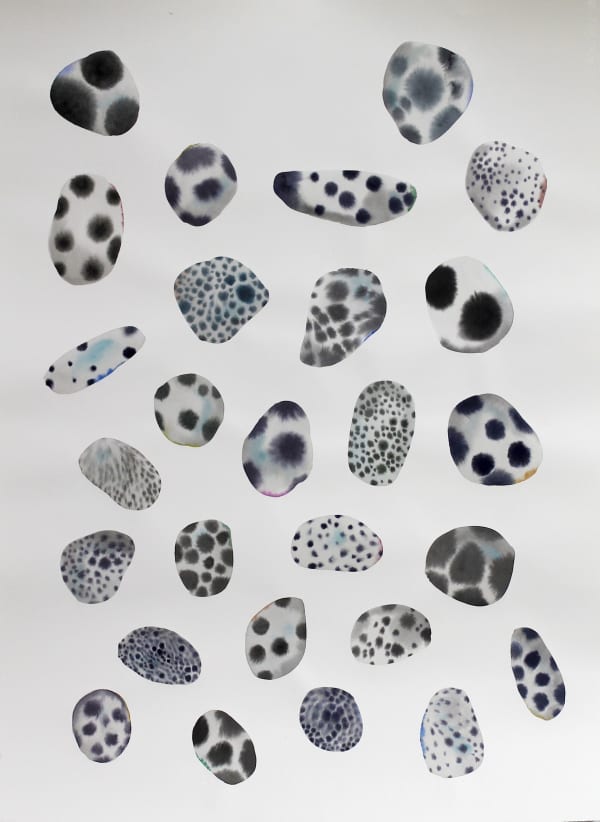‘as the oldest and wisest of all life forms, then, rocks are to be deeply respected as a category but especially as persons. They are the source of all life on the planet, and they continue to generously give themselves for maintaining all life’
George Tinker
This situation took us by surprise, no doubt.
The world has changed. And we humans - clay and
stones are witness to it.
From confinement, the idea of location becomes more relevant than ever. Sharing your life with two different countries/languages/cultures/weather is not allowed at
the moment.
Forced to stay put.
A real slap in the face.
VANESSA DONOSO LOPEZ from Kevin Kavanagh on Vimeo
-
Click on images for details
-
 Vanessa Donoso López, Petrified eternal plants, 2020
Vanessa Donoso López, Petrified eternal plants, 2020 -
 Vanessa Donoso López, Petrified object collection, Isolation day #19-#20, 2020
Vanessa Donoso López, Petrified object collection, Isolation day #19-#20, 2020 -
 Vanessa Donoso López, Cairn of two, isolation day 22, 2020
Vanessa Donoso López, Cairn of two, isolation day 22, 2020 -
 Vanessa Donoso López, Cairn, Isolation day #22, 2020
Vanessa Donoso López, Cairn, Isolation day #22, 2020 -
 Vanessa Donoso López, Cairn, Isolation day #22-#23-#24, 2020
Vanessa Donoso López, Cairn, Isolation day #22-#23-#24, 2020 -
 Vanessa Donoso López, Distanced Cairn, Isolation day 22-23-24, 2020
Vanessa Donoso López, Distanced Cairn, Isolation day 22-23-24, 2020 -
 Vanessa Donoso López, Cairn, Isolation day #25, 2020
Vanessa Donoso López, Cairn, Isolation day #25, 2020 -
 Vanessa Donoso López, Cairn, isolation day 27, 2020
Vanessa Donoso López, Cairn, isolation day 27, 2020 -
 Vanessa Donoso López, Cairn, Isolation day #29-#30, 2020Sold
Vanessa Donoso López, Cairn, Isolation day #29-#30, 2020Sold -
 Vanessa Donoso López, Cairn, Isolation day #37, 2020Sold
Vanessa Donoso López, Cairn, Isolation day #37, 2020Sold -
 Vanessa Donoso López, Cairn, isolation day #38 , 2020Sold
Vanessa Donoso López, Cairn, isolation day #38 , 2020Sold
-
-
The soil I sent from Dublin to Barcelona is heavier than ever.
Stones, soil, and clay were here before we arrived and will be here once we are gone. They have helped humanity to evolve and to create civilisation and they still are.
In clay, we find the first piece of literature ever recorded - the epic of Gilgamesh 3,000BC. Stone is considered, for some, the very first artwork or readymade in history. Even if this was not seen as art (if a definition of the term is used), we could consider, the fact that an Australopithecus may have felt attracted towards a recognisable face three million years ago and would reveal that the early hominid had some sort of capacity for symbolic thinking, necessary for the development of art and language.
The ‘Makapansgat Pebble’, as it was named, consists of jasperite cobble, carved by water, found in a cave in South Africa in 1925. This pebble is the first example of a manuport.
A manuport is a natural object, essentially a stone, which has attracted a human for its natural appearance, taken from its original contexts and deposited somewhere else chosen by this human without artificially shaping the object during this process.
This ancestral fact and the current lack of freedom of movement might explain the logic I find behind my interest in representing and collecting desired manuports, building non existing cairns or imaginary petrified plants of eternal youth that Gilgamesh might have found on the bed of the sea. Even if they are just representations of stones that might not exist.
A cairn is considered to be a collection of stones, gathered and piled by humans. Cairns are early cartographical tools, acting as signs or marking borders, paths, landmarks or graves. Some are built for the aesthetic or spiritual significance they hold in their own right. A cairn marks a human relationship with a particular landscape at a particular time. They are constituted by stones that are within walking distance of each other, often raring through the same environmental system (whether tilled by the same glacier, broken from the same mantle or worn by the same river), sitting relatively sedentary until they are guided by human hands into a stack invested with some significance. They typically stay stacked until they are dispersed again by some other environmental factor, such as the rising of the tide.
The representational aspects of the work do not try to speak for specific existing cairns, manuports, stones or scientific facts about the world, but rather, foreground the stone as a subject. The works are made out of languages and the yearning of the return of physical freedom and the encounter of other locations and clays. I look to evoke the communicative and relational capacities present in stones/clay rather than only their representational potential or role as manipulated material. The represented stones have had their own experiences and travels, and they show hypothetical compatibility between cultures through material experimentation.
Clay, soil and stones appear again as superheroes ancestral materials, almost Beings. Relieving individuals and communities to climb over a rather steep wall. Again.
Text was written by V a n e s s a D o n o s o L ó p e z











